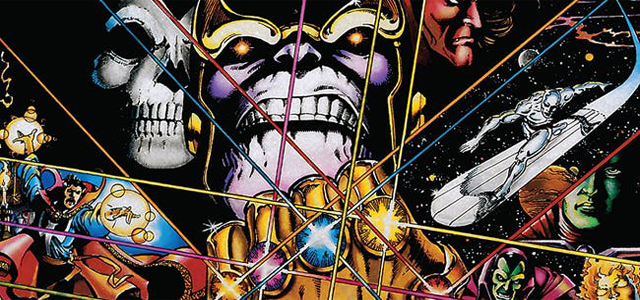Review: The Infinity Gauntlet
Written by Jim Starlin
Pencils by George Pérez and Ron Lim
Inks by Josef Rubinstein, Tom Christopher, and Bruce N Solotoff
With Avengers: Infinity War tearing up the box office (to critical acclaim), now is as good a time as any to check out the film’s source material.
The Infinity Gauntlet is a miniseries that contributes much of Infinity War’s storyline. As is the case with so many comic book stories adapted for the screen, the differences are there and the series is worth judging on its own distinct merit.
The Infinity Gauntlet is in many ways Thanos’ story. This time around, however, the mad Titan’s motivations are somewhat different. Hoping to impress his mistress, the embodiment of Death, Thanos decides to wipe out half of all life in the universe. This makes his motivation somewhat different to that of the film version, which presents him as the ultimate pragmatist who wants to wipe out half the universe in order to ultimately preserve life. Wielding the titular Infinity Gauntlet, Thanos has the powerful means at his disposal and it is up to virtually every hero in Marvel’s pantheon to stand up to him.
The story of a mad tyrant who desires the power of a god, the book brings up many interesting topics for wider consideration. Thanos describes himself as a nihlist, considering himself the ultimate barometer for morality, aiming to bend reality to his will. Subjects that The Infinity Gauntlet touches upon thereby include power, theodicy, the limits of mortality, and sin.
Writer Jim Starlin crafts a weighty, genre-defining story, with the entire mainline Marvel Comics universe serving as his canvas. There are twists and turns aplenty and Starlin deftly manages a cast that includes most major Marvel heroes and villains from the early 1990s, incorporating them all well. There are several defining hero moments and an iconic one from Thanos that alone makes the story worth reading. Thanos himself is particularly well crafted as a villain, with Stalin delivering much of his backstory and motivation.
George Pérez’s pencils are amazingly detailed, which is no mean feat, given how many characters are on the page at any given time. Pérez’s work makes so many of The Infinity Gauntlet’s moments all the more impactful. Ron Lim’s pencils accompany Pérez’s well and the result is many iconic sequences. With so much happening, it would be easy for the images to become confusing, yet special mention needs to be made about the various inkers whose work brings out the best in both pencillers’ work, far from an easy task given the extra time it would undoubtedly involve.
Originally released in 1991, The Infinity Gauntlet is a story that still holds up quite well. As might be expected from a 27 year-old work, however, The Infinity Gauntlet has several outdated elements, including the odd instance of cringe-worthy dialogue. Still, this is a relatively minor complaint and the book holds up.
Much like Watchmen and The Pride of Baghdad, The Infinity Gauntlet deserves its place on every collector’s shelf.
Jonathan Foye is Insights’ Editor













